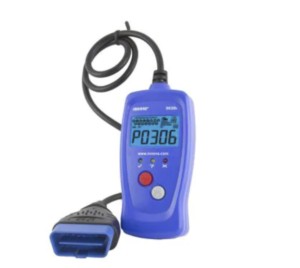The error code Obdii P0031 can be a cause for concern when your check engine light illuminates. This code, specific to the oxygen (O2) sensor heater circuit, indicates a potential issue within your vehicle’s emission control system. Specifically, P0031 signifies a “Heated Oxygen Sensor (HO2S) Heater Control Circuit Low (Bank 1, Sensor 1)”. Understanding what this means, the symptoms, and how to address it is crucial for maintaining your vehicle’s performance and environmental compliance.
Decoding the P0031 Code: Oxygen Sensor Heater Circuit Low
To fully grasp the P0031 code, it’s important to understand the role of the oxygen sensor, particularly the upstream sensor located in Bank 1, Sensor 1. This sensor, often an air/fuel ratio sensor, is positioned before the catalytic converter and plays a vital role in monitoring the air-fuel mixture exiting the engine. For optimal performance, these sensors need to reach a specific operating temperature. This is where the heater circuit comes into play.
 OBD Readers & Scan Tools
OBD Readers & Scan Tools
The heater within the oxygen sensor is designed to quickly bring the sensor to its working temperature, especially during cold starts. This ensures accurate readings are sent to the engine control module (ECM) or powertrain control module (PCM) sooner, optimizing fuel efficiency and reducing emissions. Code P0031 indicates that the ECM/PCM has detected a low voltage or low resistance in the heater control circuit for Bank 1, Sensor 1’s oxygen sensor. This “low” reading implies there might be excessive current flow or a short circuit within the heater circuit.
Symptoms Associated with OBDII P0031
When the P0031 code is triggered, you’ll likely notice the most prominent symptom: the check engine light on your dashboard will illuminate. However, other symptoms can accompany this code, although they might be subtle:
- Illuminated Check Engine Light: This is the most immediate and obvious sign.
- Reduced Fuel Efficiency: The engine might not be running at its optimal air-fuel ratio, leading to decreased gas mileage.
- Poor Engine Performance: In some cases, you might experience rough idling, hesitation during acceleration, or slightly reduced engine power.
- Failed Emissions Test: Because the oxygen sensor is crucial for emissions control, a P0031 code can cause your vehicle to fail an emissions test.
It’s important to note that these symptoms can be indicative of various engine problems. Therefore, using an OBD-II scanner to confirm the P0031 code is essential for accurate diagnosis.
Potential Causes of the P0031 Code
Several factors can lead to a P0031 code. Pinpointing the exact cause requires a systematic diagnostic approach. Common culprits include:
- Faulty Oxygen Sensor Heater: The heater element within the sensor itself may have failed due to age, wear, or electrical damage.
- Wiring Issues: Damaged, corroded, or shorted wiring within the heater circuit can disrupt the electrical flow. This includes issues with connectors, wiring harnesses, and ground circuits.
- Blown Fuse: A fuse protecting the oxygen sensor heater circuit might be blown, interrupting power supply.
- Relay Problems: The relay controlling the heater circuit could be malfunctioning.
- ECM/PCM Failure (Less Common): In rare cases, a fault within the ECM/PCM itself could be misinterpreting sensor readings or incorrectly controlling the heater circuit.
Diagnosing and Resolving the P0031 Code
Diagnosing a P0031 code requires a step-by-step approach, often involving electrical testing. Here’s a general procedure, but always refer to your vehicle’s specific repair manual for detailed instructions and specifications:
- OBD-II Scan and Verification: Confirm the P0031 code and check for any other related trouble codes. Clear the codes and see if P0031 returns.
- Fuse and Relay Inspection: Locate and inspect the fuse and relay associated with the oxygen sensor heater circuit. Check for blown fuses and faulty relays. Replace if necessary.
- Visual Wiring Inspection: Carefully examine the wiring and connectors leading to the Bank 1 Sensor 1 oxygen sensor. Look for any signs of damage, fraying, corrosion, or loose connections. Repair or replace damaged wiring.
- Voltage and Ground Circuit Test: Use a multimeter to check for proper voltage supply to the heater circuit (typically 12V) and verify a good ground connection. Refer to your service manual for specific voltage readings.
- Heater Resistance Test: Measure the resistance of the oxygen sensor heater circuit. Compare the reading to the specifications in your service manual. A significantly low resistance reading (below specification, often below 0.8 ohms but varies) can confirm a short or internal heater fault.
- Oxygen Sensor Replacement: If wiring and power supply are confirmed to be good, and the resistance reading is out of spec, replacing the Bank 1 Sensor 1 oxygen sensor is often the next step.
- ECM/PCM Diagnosis (If Necessary): If all other components are ruled out, and the issue persists, ECM/PCM malfunction might be considered as a last resort. This usually requires professional diagnostic equipment and expertise.
Fixing the P0031 Code: Common Solutions
The most frequent fix for a P0031 code is replacing the Bank 1 Sensor 1 oxygen sensor. Over time, the heater element within the sensor can degrade and fail. However, depending on the diagnosis, other solutions may be necessary:
- Oxygen Sensor Replacement (Bank 1, Sensor 1): This is often the primary solution, especially in older vehicles.
- Wiring Repair: Repairing or replacing damaged wiring, connectors, or fixing ground issues can resolve the problem if wiring is the root cause.
- Fuse or Relay Replacement: Replacing a blown fuse or faulty relay is a simple fix if these components are the issue.
- ECM/PCM Repair or Replacement (Rare): In uncommon cases, ECM/PCM issues may require professional repair or replacement.
Addressing a P0031 code promptly is important to ensure your vehicle runs efficiently, minimizes emissions, and avoids potential further engine problems. If you are not comfortable performing these diagnostic and repair steps yourself, it is recommended to seek assistance from a qualified automotive technician. You can find the necessary parts for your repair at your local AutoZone store, or consult with one of their Preferred Shops for professional service.
